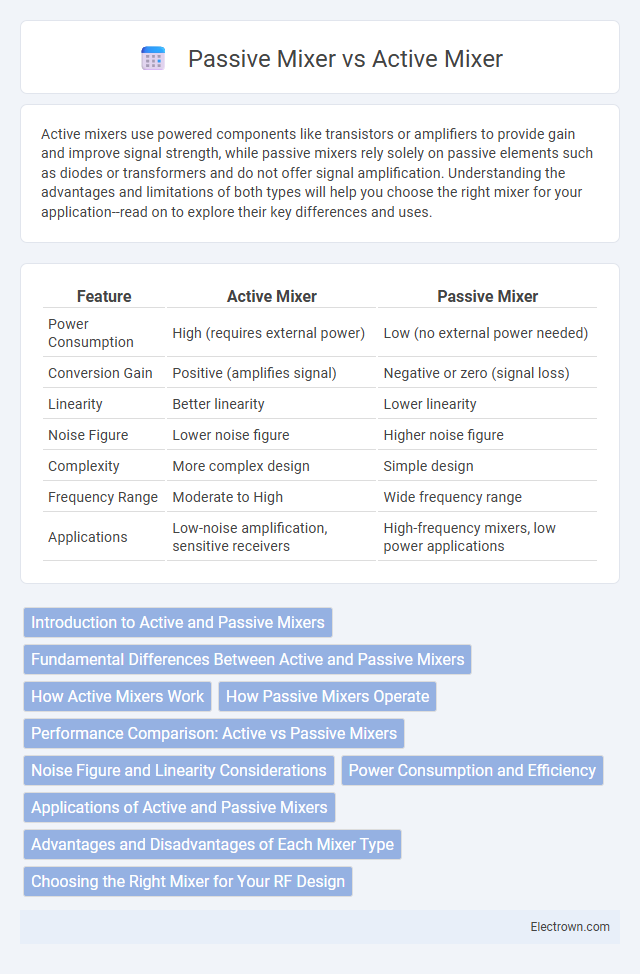Active mixers use powered components like transistors or amplifiers to provide gain and improve signal strength, while passive mixers rely solely on passive elements such as diodes or transformers and do not offer signal amplification. Understanding the advantages and limitations of both types will help you choose the right mixer for your application--read on to explore their key differences and uses.
Table of Comparison
| Feature | Active Mixer | Passive Mixer |
|---|---|---|
| Power Consumption | High (requires external power) | Low (no external power needed) |
| Conversion Gain | Positive (amplifies signal) | Negative or zero (signal loss) |
| Linearity | Better linearity | Lower linearity |
| Noise Figure | Lower noise figure | Higher noise figure |
| Complexity | More complex design | Simple design |
| Frequency Range | Moderate to High | Wide frequency range |
| Applications | Low-noise amplification, sensitive receivers | High-frequency mixers, low power applications |
Introduction to Active and Passive Mixers
Active mixers use powered electronic components like transistors to amplify signals, providing gain and improved conversion efficiency in RF applications. Passive mixers rely on non-linear passive components, such as diodes or switches, to mix signals without additional power, resulting in lower noise but no gain and higher signal loss. Your choice between active and passive mixers depends on requirements like noise figure, linearity, and power consumption in your RF design.
Fundamental Differences Between Active and Passive Mixers
Active mixers use powered components like transistors or FETs to amplify and convert signals, offering gain and better linearity, while passive mixers rely solely on passive elements such as diodes or switches, resulting in signal loss but simpler design and higher linearity in some cases. Active mixers typically provide lower conversion loss and improved isolation between ports, enhancing system performance in RF applications. Passive mixers, despite having conversion loss, are favored for their robustness, wide bandwidth, and superior noise figure due to the absence of active devices.
How Active Mixers Work
Active mixers utilize transistors or operational amplifiers powered by an external DC supply to convert and amplify signals simultaneously, enabling frequency translation with gain. They operate by mixing input signals at different frequencies, generating sum and difference frequencies efficiently while maintaining signal integrity. Your choice of an active mixer affects noise figure, linearity, and overall system performance, making them ideal for low-level signal applications.
How Passive Mixers Operate
Passive mixers operate by using diodes or switches to combine input signals without requiring an external power source, relying on the nonlinear characteristics of these components to mix frequencies. Their operation results in lower noise figures and high linearity but often introduces insertion loss, necessitating subsequent amplification in the signal chain. Passive mixers are favored in applications demanding low distortion and minimal power consumption, such as in RF receivers and communication systems.
Performance Comparison: Active vs Passive Mixers
Active mixers offer higher conversion gain, improved linearity, and better isolation compared to passive mixers, making them ideal for applications requiring low noise and high signal integrity. Passive mixers, while more power-efficient and simpler in design, typically exhibit higher insertion loss and lower overall sensitivity, which can limit performance in weak signal environments. Your choice depends on balancing system requirements such as power consumption, noise figure, and linearity for optimal mixer performance.
Noise Figure and Linearity Considerations
Active mixers generally offer lower noise figures compared to passive mixers, enhancing signal sensitivity in communication systems. Passive mixers provide higher linearity, handling large input signals without distortion, which is critical for maintaining signal integrity. Your choice between active and passive mixers depends on balancing noise performance with linearity requirements in specific applications.
Power Consumption and Efficiency
Active mixers consume more power due to their use of active components like transistors, which amplify signals and enhance conversion gain, resulting in higher efficiency for low-noise applications. Passive mixers, relying on passive components such as diodes or switches, exhibit minimal power consumption but typically have conversion loss, making them less efficient in preserving signal strength. Your choice between active and passive mixers should consider the trade-off between power consumption and signal efficiency based on the application's performance requirements.
Applications of Active and Passive Mixers
Active mixers, known for their high gain and improved isolation, are ideal for applications in RF communication systems, such as cellular transceivers and satellite receivers, where signal amplification and low noise are critical. Passive mixers, with their simplicity and linearity, are commonly used in low-power devices, instrumentation, and signal modulation tasks where minimal distortion and high linearity are required. Your choice between active and passive mixers depends on factors like power consumption, linearity, and the specific frequency range of your application.
Advantages and Disadvantages of Each Mixer Type
Active mixers provide gain, improve signal-to-noise ratio, and offer better isolation, making them suitable for low-level RF signal processing but require external power and can introduce nonlinear distortion. Passive mixers are simple, reliable, and linear with no power consumption, ideal for high-frequency applications, but they suffer from conversion loss and poor noise figure. Choosing between them depends on the trade-off between signal integrity, power availability, and application frequency requirements.
Choosing the Right Mixer for Your RF Design
Selecting the ideal mixer for your RF design hinges on balancing performance and power consumption. Active mixers provide higher gain and better isolation, making them suitable for applications demanding strong signal integrity and low noise figures. Passive mixers, with their simplicity and low power usage, excel in situations where linearity and broadband operation are critical, helping you optimize your design for specific signal environments.
Active mixer vs passive mixer Infographic

 electrown.com
electrown.com